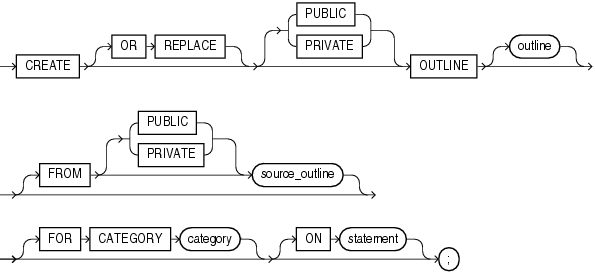| Oracle® Database SQL Language Reference 11g Release 2 (11.2) Part Number E26088-02 |
|
|
PDF · Mobi · ePub |
| Oracle® Database SQL Language Reference 11g Release 2 (11.2) Part Number E26088-02 |
|
|
PDF · Mobi · ePub |
Note:
Stored outlines will be desupported in a future release in favor of SQL plan management. In Oracle Database 11g Release 2 (11.2), stored outlines continue to function as in past releases. Oracle strongly recommends that you use SQL plan management for new applications. SQL plan management creates SQL plan baselines, which offer superior SQL performance stability compared with stored outlines.You can migrate existing stored outlines to SQL plan baselines by using the MIGRATE_STORED_OUTLINE function of the DBMS_SPM package or Enterprise Manager DB Control. When the migration is complete, the stored outlines are marked as migrated and can be removed. You can drop all migrated stored outlines on your system by using the DROP_MIGRATED_STORED_OUTLINE function of the DBMS_SPM package.
See Also: Oracle Database Performance Tuning Guide for more information about SQL plan management and Oracle Database PL/SQL Packages and Types Reference for information about the DBMS_SPM package
Use the CREATE OUTLINE statement to create a stored outline, which is a set of attributes used by the optimizer to generate an execution plan. You can then instruct the optimizer to use a set of outlines to influence the generation of execution plans whenever a particular SQL statement is issued, regardless of changes in factors that can affect optimization. You can also modify an outline so that it takes into account changes in these factors.
Note:
The SQL statement you want to affect must be an exact string match of the statement specified when creating the outline.See Also:
Oracle Database Performance Tuning Guide for information on execution plans
ALTER OUTLINE for information on modifying an outline
ALTER SESSION and ALTER SYSTEM for information on the USE_STORED_OUTLINES and USE_PRIVATE_OUTLINES parameters
To create a public or private outline, you must have the CREATE ANY OUTLINE system privilege.
If you are creating a clone outline from a source outline, then you must also have the SELECT_CATALOG_ROLE role.
You can enable or disable the use of stored outlines dynamically for an individual session or for the system:
Enable the USE_STORED_OUTLINES parameter to use public outlines.
Enable the USE_PRIVATE_OUTLINES parameter to use private stored outlines.
See Also:
Oracle Database Performance Tuning Guide for information on using outlines for performance tuning
Note:
None of the clauses afteroutline are required. However, you must specify at least one clause after outline, and it must be either the FROM clause or the ON clause.Specify OR REPLACE to replace an existing outline with a new outline of the same name.
Specify PUBLIC if you are creating an outline for use by PUBLIC. This is the default.
Specify PRIVATE to create an outline for private use by the current session only. The data of this outline is stored in the current schema.
Specify the unique name to be assigned to the stored outline. If you do not specify outline, then the database generates an outline name.
See Also:
"Creating an Outline: Example"Use the FROM clause to create a new outline by copying an existing one. By default, Oracle Database looks for source_category in the public area. If you specify PRIVATE, then the database looks for the outline in the current schema.
Restriction on Copying an Outline If you specify the FROM clause, then you cannot specify the ON clause.
See Also:
"Creating a Private Clone Outline: Example" and "Publicizing a Private Outline to the Public Area: Example"Specify an optional name used to group stored outlines. For example, you could specify a category of outlines for end-of-week use and another for end-of-quarter use. If you do not specify category, then the outline is stored in the DEFAULT category.
Specify the SQL statement for which the database will create an outline when the statement is compiled. This clause is optional only if you are creating a copy of an existing outline using the FROM clause.
You can specify any one of the following statements: SELECT, DELETE, UPDATE, INSERT ... SELECT, CREATE TABLE ... AS SELECT.
Restrictions on the ON Clause This clause is subject to the following restrictions:
If you specify the ON clause, then you cannot specify the FROM clause.
You cannot create an outline on a multitable INSERT statement.
The SQL statement in the ON clause cannot include any DML operation on a remote object.
Note:
In subsequent statements, you can specify additional outlines for the same SQL statement, but each outline for the same statement must specify a different category in theCATEGORY clause.Creating an Outline: Example The following statement creates a stored outline by compiling the ON statement. The outline is called salaries and is stored in the category special.
CREATE OUTLINE salaries FOR CATEGORY special ON SELECT last_name, salary FROM employees;
When this same SELECT statement is subsequently compiled, if the USE_STORED_OUTLINES parameter is set to special, the database generates the same execution plan as was generated when the outline salaries was created.
Creating a Private Clone Outline: Example The following statement creates a stored private outline my_salaries based on the public category salaries created in the preceding example.
CREATE OR REPLACE PRIVATE OUTLINE my_salaries FROM salaries;
Publicizing a Private Outline to the Public Area: Example The following statement copies back (publicizes) a private outline to the public area after private editing:
CREATE OR REPLACE OUTLINE public_salaries FROM PRIVATE my_salaries;